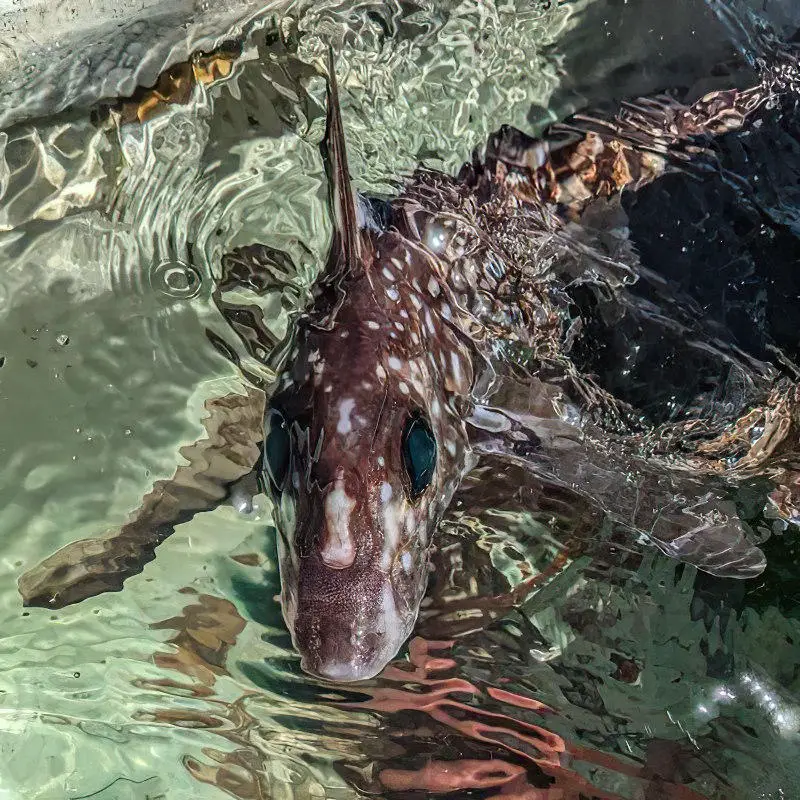A team of scientists from the University of Florida and the Seattle Aquarium is embarking on a unique expedition to explore the elusive ghost sharks, a peculiar deep-sea species found in the Pacific Northwest. Using Remotely Operated Underwater Vehicles (ROVs), they aim to uncover the secrets of the Pacific spotted ratfish, also known as ghost sharks, and investigate their breeding habitats and embryonic development.
Ghost sharks, formally referred to as chimaeras, are a fascinating and little-understood group of fishes, distinct from sharks and rays by millions of years of evolution. Their preference for deep waters has limited our knowledge about them, but there are certain areas, like the Salish Sea off the coast of Washington, where they venture into shallower waters during breeding and feeding seasons, particularly in the summer.
By locating ghost shark embryos, the researchers hope to gain insights into the developmental processes that give rise to their unique morphologies and biological characteristics. These intriguing creatures possess round, rabbit-like eyes that aid in nocturnal hunting, and their ever-growing tooth plates have earned them the nickname “ratfish.” Unlike sharks, their skin lacks teeth, but the males have an unusual bulb on their forehead called a tenaculum, which they use during copulation.
While past deep-water trawling projects have helped find adult ghost sharks, studying mature fish alone hasn’t shed much light on their development. This new expedition aims to locate their nursery grounds to better understand their life cycle.
Funding for the ghost shark exploration project comes from a National Science Foundation grant focused on shark skin teeth and a UF start-up grant. The team also hopes to uncover insights into the origins of teeth, which could have implications for human tooth regeneration.
The researchers have already started their journey, operating the ROV in the waters off Seattle, searching for ghost shark nesting sites. They plan to deploy the ROV deeper in Elliot Bay and other locations around the San Juan Islands, capturing 360-degree views with its cameras to create a virtual reality scene of the ocean depths for further analysis.
The project not only offers a unique opportunity to study these understudied deep-water fish but also contributes to conservation efforts to protect this charismatic species. As they delve into the mysteries of ghost sharks, the researchers hope to shed light on their lives and ensure their preservation for the future.
Table of Contents
Frequently Asked Questions (FAQs) about Ghost sharks
What are ghost sharks?
Ghost sharks, formally known as chimaeras, are enigmatic deep-sea creatures related to sharks and rays but evolved separately over millions of years. They have unique features, such as big round eyes and ever-growing tooth plates.
Why are ghost sharks considered elusive?
Ghost sharks are elusive due to their preference for deep waters, making them challenging to study. However, certain locations, like the Salish Sea in Washington, offer opportunities to observe them in shallower waters during breeding and feeding.
How are researchers studying ghost sharks?
A team of researchers from the University of Florida and the Seattle Aquarium is utilizing Remotely Operated Underwater Vehicles (ROVs) to explore ghost shark breeding habitats and embryonic development.
What do the researchers hope to discover?
The researchers aim to locate ghost shark embryos to gain insights into their developmental processes and the unique morphologies and biological characteristics that define this mysterious species.
How are ghost sharks different from other fish?
Ghost sharks possess rabbit-like eyes that aid their nocturnal hunting and lack teeth on their skin. Male ghost sharks have a peculiar bulb called a tenaculum, used during copulation. They are distinct from sharks and rays, having diverged in evolution over a span of 400 million years.
How is the research funded?
The ghost shark exploration project receives funding from a National Science Foundation grant focused on shark skin teeth and a UF start-up grant.
What is the significance of the research?
Studying ghost sharks not only helps unravel mysteries of deep-sea life but also has implications for conservation efforts to protect this charismatic and little-understood species.
Where is the research taking place?
The research is being conducted in the Pacific Northwest, particularly in the waters off Seattle, Elliot Bay, and other sites around the San Juan Islands.
What technology is being used in the research?
The researchers are using Remotely Operated Underwater Vehicles (ROVs), which are essentially underwater drones equipped with cameras to capture images of the ghost sharks’ habitats.
How can the research benefit humans?
Apart from understanding the ghost shark’s biology, the research also explores the origins of teeth, which could have potential implications for human tooth regeneration.
More about Ghost sharks
- University of Florida: https://www.ufl.edu/
- Seattle Aquarium: https://www.seattleaquarium.org/
- Remotely Operated Underwater Vehicles (ROVs): https://en.wikipedia.org/wiki/Remotely_operated_underwater_vehicle
- National Science Foundation: https://www.nsf.gov/
- Pacific spotted ratfish (Hydrolagus colliei): https://en.wikipedia.org/wiki/Hydrolagus_colliei
- Salish Sea: https://en.wikipedia.org/wiki/Salish_Sea



5 comments
ghost sharks r sooo cool! the researchers r diving deep to find em. hope they learn lots bout these spooky fishies.
ghost sharks = mysteries of da deep. big eyes like rabbits, no teeth on skin. gotta protect em, they r unique and charismatic!
whoa, chimaeras, sharks, rays, all related? crazy stuff! they use ROVs to find where ghost sharks lay eggs. amazin!
research funded by NSF, UF, and stuff. virtual reality scenes of ocean depths? mind-blowing! can’t wait for the discoveries!
ghosts shark sex life? they got some crazy stuff goin on. those bulb-head dudes, tenaculum! fascinating and weird at the same time.